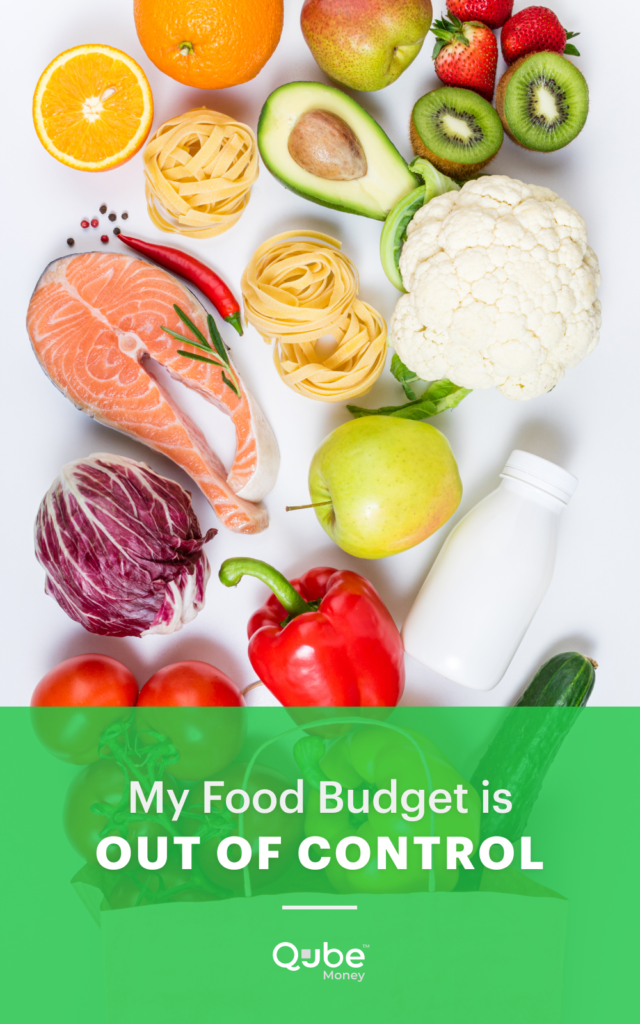When my wife and I started budgeting, we quickly realized that aside from our housing expenses (rent, utilities, insurance, etc.), we were spending more on food than any other category. Our food budget was out of control!
Food spending was our Achilles’ heel, and it was always our most significant non-housing expense until we had a baby and started to pay for childcare.
When we got serious about managing our money, we went through all of our bank statements for the prior six months and were surprised by how much our grocery spending varied from month to month. This presented a challenge because we wanted to be able to predict precisely how much we would be spending each month.
Having a fixed food budget would allow us to focus on paying down our debts and save for upcoming expenses.
It took some fine-tuning and a few months to figure it out, but by using these food budgeting tips, we were able to reduce our monthly food budget and continue to feed our family with delicious (and mostly healthy!) meals.
Related: 6 Causes of Overspending That Are Holding You Back
How to Create a Grocery & Food Budget
The first step to regaining control is to create a rigid food budget and learning to budget for groceries. An excellent place to start is to open up all of your bank statements (checking, savings, and credit card accounts) and figure out how much you’re currently spending on food each month.
We went through six months of our statements, and we recommend that you review at least the last three months. Break things up into two categories: one for groceries and one for restaurants. Add up how much you spent in each bucket and divide that number by the number of months you’re reviewing.
For example, if you spent $310, $265, $190, and $350 on groceries over the last four months, you’d add all of them up first. $310+$265+$190+$350=$1,115. Then, take that total and divide it by the number of months: $1,115/4=$278.75.
In our example above, the average amount of money we spent on groceries was $278.75 each month. Repeat the same steps for money spent on restaurants.
We decided to add every cent we spend at restaurants in our ‘restaurant’ budget. This includes things like going to a happy hour after work, even if you only have a glass or two of wine. It made the most sense for us to include this in our budget to keep things simple and easy to calculate.
Now you have an idea of how much you’ve been spending on food. If your eyes popped out of your head, pick them up, and put them back in place. I know exactly how it feels to have your food spending out of control.
Trim Your Food Budget
Some experts recommend spending 5-10% of your total budget on groceries. I hesitate to share any fixed recommendations because this depends on how large your family is, the price of food where you live, and on any dietary preferences (allergies, medical issues requiring a special diet, etc.).
What I did and what I’ve recommended to my friends is taking the average amount of money you spent on groceries (calculated above using four months) and reducing that by 10%.
We noticed that we were spending a lot of money at restaurants. We didn’t go to fancy places, but life is busy, and eating out is convenient. This was an area we knew we could make a difference, and we decided to reduce our restaurant budget by 25%.
By being more aggressive in reducing our restaurant budget, we were able to focus on eating more of our meals at home. Not only did this save us money, but we were more healthy and shaved inches from our waistlines.
To keep using the same numbers as our example above: $278.75 – 10% = new grocery budget. $278.75 X 0.1 = $27.88; $278.75 – $27.88 = $250.87.
Now take your new budget amount and use that as a guide for the first month. We gave ourselves 3 months of wiggle room to figure out an amount that was sustainable and not too restrictive.
Related: Do More, Not Less With a Budget
Grocery Store
Believe it or not, we reduced our grocery bill even further by using a few additional tips and tricks.
How to Make A Weekly Menu
Each Sunday, we plan out our meals for the week and make a detailed shopping list. We pick recipes with shared ingredients to minimize waste. Also, we found that by using seasonal ingredients or items on sale, each dollar goes a lot further.
We always have leftovers, so we plan when we will eat the leftovers, too. For example, If we make fajitas Sunday night, we will expect to have that again on Tuesday evening.
If you aren’t used to preparing your meals this way, it will be an adjustment. Don’t give up if you don’t enjoy cooking. After a couple of months, you’ll love the variety of different things you can now make, and cooking is a life-long skill that you’ll have to learn sooner or later, unless you plan to eat Mac and Cheese forever.
Shopping List
Having a shopping list is essential. Grocery stores are marketing geniuses. Every detail of the store is designed so that you spend more money. They place more expensive items at eye-level and line the registers with snacks and candy. If you have a shopping list and check the bottom shelves for cheaper alternatives, you won’t fall into their trap.
Remember to stick to the outer perimeter of the store and only venture into the center aisles for specific items. The outside aisles are where you’ll find the produce, meat, dairy departments, and the central aisles contain mostly pre-packaged junk food.
This means you’ll be preparing and consuming healthier meals, which don’t need to cost you more now but will undoubtedly save you in healthcare expenses over your lifetime.
Another thing we do is we buy organic foods strategically. I love referencing the ‘dirty dozen foods list‘ to see which foods are worth buying organic and which aren’t. They list out which foods are typically contaminated the most, and which aren’t. For example, we no longer purchase organic avocados, corn, or onions, but we always buy organic strawberries, tomatoes, and spinach. This strategy has saved us a lot of money.
If there’s an item on your grocery list that has a cheaper generic brand, test it out. You may not be able to tell the difference; many brands make generic products in the same factories as name-brand products.
Shop Online
If you find yourself struggling to stick to a food budget, try shopping online.
Most grocery stores offer pick-up or delivery services. We found that by shopping online, we practically eliminated spending money on unplanned items. The chips, cookies, and frozen pizzas that we didn’t intend to buy no longer made it into our home. Online shopping made it nearly impossible to make impulsive decisions.
It’s important to note that some stores mark up their prices online and charge a small fee for pick-up or delivery. However, you may still save money because you won’t be tempted to buy extra items that aren’t on your grocery list. Stick to your budget and ask your partner or a friend to place an order for you if you struggle with adding extra items, even when shopping online.
Buy Grocery Staples In Bulk
If there are certain items you always buy or use in large quantities, you could save money by shopping in bulk. By shopping in bulk, you pay less per unit, which over a year can add up to be significant in savings. Depending on where you live, there might be a warehouse-type store near you that doesn’t require a membership.
Buy Non-Perishable Food At The Dollar Store
Money experts DJ and Dannie Vann, creators of penniestowealth.com, recommend buying non-perishable items and snacks from the dollar store. They say, “We are both vegan, but our grocery budget is only $300 per month. The biggest key to our shopping success is that we make a plan in advance, buy our staple kitchen items in bulk, and we always craft meals around the weekly in-store deals. Our best-kept secret is that we even buy some non-perishables and snacks from the dollar store to save even more money!”
When I first heard this advice, I was a little skeptical because the local dollar store wasn’t on my radar for food, but I couldn’t believe the wide variety of foods and snacks they offer.
Restaurants
As I shared earlier, we quickly found that we were spending too much money at restaurants, which was hurting our wallets and our waistlines. We needed to make a drastic change in this area and were surprised by how much we could save by making a few small adjustments.
For reference, we allocate about ⅓ of our food budget to restaurants and ⅔ to groceries.
Instead of eating fast food multiple times a month and not enjoying the food or the experience, we plan ahead. We go to a restaurant 1- 2 times per month and grab something fast another 2-3 times per month.
This is the perfect balance for us. We still get to hit our favorite spots and leave room for quick bites when we are traveling.
Make Things At Home That You Love Getting At Restaurants
The main reason we were eating out was because of convenience. We decided to start keeping some easy-to-make items at home so we can no longer use that excuse. Instead of going to our favorite Indian restaurant, we keep some Trader Joe’s frozen Indian meals on hand. Rather than spending $20-$30 on dinner, we pay less than half of that. Not only do we save money, but it’s usually faster, too.
Look, I am not going to pretend that a frozen Trader Joe’s meal is as good, but the restaurant is also not ten times better, so it’s a trade-off I am happy to make.
Look At Menus Before Heading Out
Taking a look at the menu before you get to the restaurant is an easy way to save money. When you’re hungry and have a full list of food in front of you, it’s easy to order too much. Try to decide what you’ll order in advance so you won’t make impulsive decisions when you get there.
Share Food
Appetizers cost just as much as entrees, so if you’re going to order one, share it. When we go out on date nights, we will often share an appetizer and an entree. This is more than enough food, and there’s always room for dessert! If you don’t have anyone to share with, ask your server to box half of it ahead of time. You’ll eat less and have a meal ready for another time.
Save On Drinks
Drinks are big money makers for restaurants. By not paying for soda or alcohol, we can stretch our restaurant budget. If you love the carbonation in soda, some restaurants offer soda water for free. Just ask. You can also share a milkshake or large mug of beer.
Save those expensive drinks for occasions like your birthday or when you have a friend visiting from across the country. You’ll save a lot of money by not routinely paying for soda you don’t need.
Pack Your Lunch
Buying lunch every day is crazy expensive and will derail even the best-planned food budget. My wife packs the same lunch every day: a peanut butter sandwich with pretzels and fresh fruit (usually a banana, oranges, or strawberries). We have also been able to save money by keeping the bread in the freezer; it lasts longer, and we don’t have to throw out moldy bread.
Following these tips can help you create and maintain a reasonable food budget, which will ultimately help you attain your financial goals sooner.
I know it worked for us!





![Everything You Need to Know About the Cash Envelope System [+ Sample Budget]](https://marketing.qubemoney.com/wp-content/uploads/2020/01/1-20-20-the-cash-envelope-system-blog2-440x264.png)


